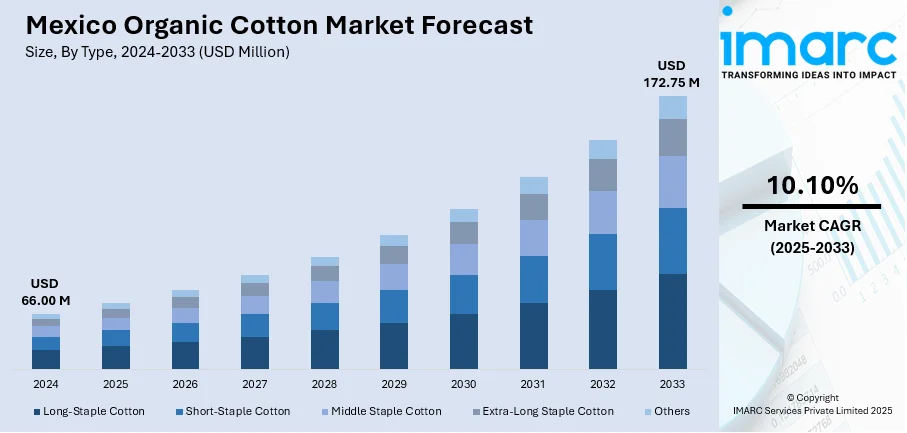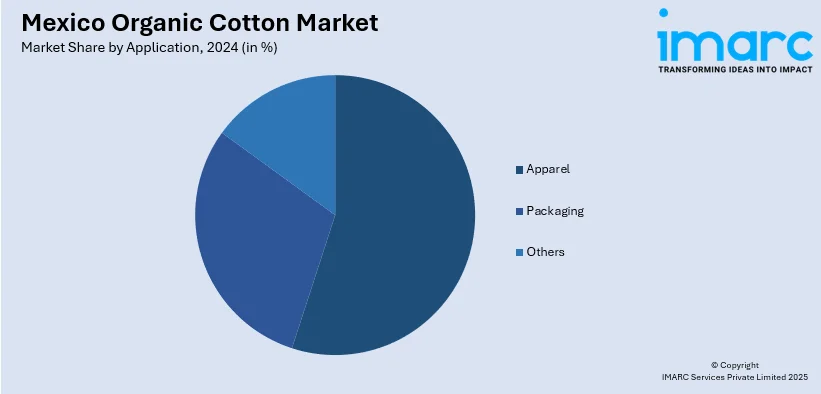
Mexico Organic Cotton Market Size, Share, Trends and Forecast by Type, Quality Type, Application, and Region, 2025-2033
Mexico Organic Cotton Market Overview:
The Mexico organic cotton market size reached USD 66.00 Million in 2024. Looking forward, IMARC Group expects the market to reach USD 172.75 Million by 2033, exhibiting a growth rate (CAGR) of 10.10% during 2025-2033. At present, retail channels, both online and offline, are endorsing organic cotton products by means of transparent labeling, fostering responsible user habits. In addition, influencers, bloggers, and environmentally aware celebrities are highlighting organic cotton apparel, infant items, and household textiles, motivating their audiences to adopt ethical decisions. This is fueling the Mexico organic cotton market share.
|
Report Attribute
|
Key Statistics
|
|---|---|
|
Base Year
|
2024
|
|
Forecast Years
|
2025-2033
|
|
Historical Years
|
2019-2024
|
| Market Size in 2024 | USD 66.00 Million |
| Market Forecast in 2033 | USD 172.75 Million |
| Market Growth Rate 2025-2033 | 10.10% |
Mexico Organic Cotton Market Trends:
Increasing demand for sustainable textiles
Rising demand for sustainable textiles is positively influencing the market in Mexico. People are becoming aware about the environmental impact of conventional cotton farming, including pesticide use, water utilization, and soil degradation. Consequently, they are shifting preferences towards organic cotton, which employs natural farming methods, reduces chemical exposure, and promotes biodiversity. This transition is especially evident among young, urban, and environmentally conscious shoppers who seek clothing, home textiles, and personal care items made from eco-friendly materials. Local and international brands are responding by launching organic cotton collections and advocating for their sustainability credentials. Fashion designers and retailers continue to emphasize the ethical sourcing, softness, and durability of organic cotton, making it more appealing to mainstream buyers. Government efforts and awareness campaigns are also supporting eco-friendly textile adoption. The use of organic cotton aligns with broader goals of minimizing carbon footprints and conserving water resources. Additionally, the thriving hospitality industry is utilizing organic cotton for its safety and environmental benefits. As per industry reports, the size of the Mexico hospitality industry market is projected to be USD 24.24 Billion in 2025, and is anticipated to grow to USD 31.78 Billion by 2030, with a CAGR of 5.57% throughout the forecast period (2025-2030). Online and offline retail channels are promoting organic cotton products through clear labeling and storytelling, encouraging responsible user behavior.

To get more information on this market, Request Sample
Growing impact of social media platforms
Rising influence of social media channels is fueling the Mexico organic cotton market growth. According to the DataReportal, in January 2024, Mexico had 90.20 Million social media users, representing 70.0% of the entire population. With wider adoption, social media platforms play a major role in spreading awareness about sustainable fashion and eco-friendly lifestyles. Influencers, bloggers, and eco-conscious celebrities are showcasing organic cotton clothing, baby products, and home textiles, encouraging followers to make ethical choices. Visual content highlighting the softness, purity, and health benefits of organic cotton attracts attention and inspires people to try these products. Social media campaigns by brands emphasize transparency, eco-certifications, and responsible sourcing, building trust among digital-savvy buyers. User-generated content and product reviews further influence purchase decisions by highlighting real-life experiences with organic cotton items. Hashtags and viral trends related to sustainability help amplify the message and broaden reach. Younger audiences, in particular, engage with eco-friendly content and prefer products that align with their values. As more people are turning to social platforms for shopping inspiration, the visibility and demand for organic cotton is growing steadily.
Mexico Organic Cotton Market Segmentation:
IMARC Group provides an analysis of the key trends in each segment of the market, along with forecasts at the country and regional levels for 2025-2033. Our report has categorized the market based on type, quality type, and application.
Type Insights:
- Long-Staple Cotton
- Short-Staple Cotton
- Middle Staple Cotton
- Extra-Long Staple Cotton
- Others
The report has provided a detailed breakup and analysis of the market based on the type. This includes long-staple cotton, short-staple cotton, middle staple cotton, extra-long staple cotton, and others.
Quality Type Insights:
- Supima/Pima
- Upland
- Giza
- Others
A detailed breakup and analysis of the market based on the quality type have also been provided in the report. This includes supima/pima, upland, giza, and others.
Application Insights:

- Apparel
- Packaging
- Others
The report has provided a detailed breakup and analysis of the market based on the application. This includes apparel, packaging, and others.
Regional Insights:
- Northern Mexico
- Central Mexico
- Southern Mexico
- Others
The report has also provided a comprehensive analysis of all the major regional markets, which include Northern Mexico, Central Mexico, Southern Mexico, and others.
Competitive Landscape:
The market research report has also provided a comprehensive analysis of the competitive landscape. Competitive analysis such as market structure, key player positioning, top winning strategies, competitive dashboard, and company evaluation quadrant has been covered in the report. Also, detailed profiles of all major companies have been provided.
Mexico Organic Cotton Market News:
- In April 2025, Arzee International, a manufacturer of sustainable cotton clothing, inaugurated its Mexico City office and introduced a B2B line. Arzee International provided eco-friendly cotton clothing to designers and prominent national labels, offering a range of services that encompassed development, sourcing raw materials, sampling, and large-scale production.
Mexico Organic Cotton Market Report Coverage:
| Report Features | Details |
|---|---|
| Base Year of the Analysis | 2024 |
| Historical Period | 2019-2024 |
| Forecast Period | 2025-2033 |
| Units | Million USD |
| Scope of the Report |
Exploration of Historical Trends and Market Outlook, Industry Catalysts and Challenges, Segment-Wise Historical and Future Market Assessment:
|
| Types Covered | Long-Staple Cotton, Short-Staple Cotton, Middle Staple Cotton, Extra-Long Staple Cotton, Others |
| Quality Types Covered | Supima/Pima, Upland, Giza, Others |
| Applications Covered | Apparel, Packaging, Others |
| Regions Covered | Northern Mexico, Central Mexico, Southern Mexico, Others |
| Customization Scope | 10% Free Customization |
| Post-Sale Analyst Support | 10-12 Weeks |
| Delivery Format | PDF and Excel through Email (We can also provide the editable version of the report in PPT/Word format on special request) |
Key Questions Answered in This Report:
- How has the Mexico organic cotton market performed so far and how will it perform in the coming years?
- What is the breakup of the Mexico organic cotton market on the basis of type?
- What is the breakup of the Mexico organic cotton market on the basis of quality type?
- What is the breakup of the Mexico organic cotton market on the basis of application?
- What is the breakup of the Mexico organic cotton market on the basis of region?
- What are the various stages in the value chain of the Mexico organic cotton market?
- What are the key driving factors and challenges in the Mexico organic cotton market?
- What is the structure of the Mexico organic cotton market and who are the key players?
- What is the degree of competition in the Mexico organic cotton market?
Key Benefits for Stakeholders:
- IMARC’s industry report offers a comprehensive quantitative analysis of various market segments, historical and current market trends, market forecasts, and dynamics of the Mexico organic cotton market from 2019-2033.
- The research report provides the latest information on the market drivers, challenges, and opportunities in the Mexico organic cotton market.
- Porter's five forces analysis assist stakeholders in assessing the impact of new entrants, competitive rivalry, supplier power, buyer power, and the threat of substitution. It helps stakeholders to analyze the level of competition within the Mexico organic cotton industry and its attractiveness.
- Competitive landscape allows stakeholders to understand their competitive environment and provides an insight into the current positions of key players in the market.
Need more help?
- Speak to our experienced analysts for insights on the current market scenarios.
- Include additional segments and countries to customize the report as per your requirement.
- Gain an unparalleled competitive advantage in your domain by understanding how to utilize the report and positively impacting your operations and revenue.
- For further assistance, please connect with our analysts.
 Request Customization
Request Customization
 Speak to an Analyst
Speak to an Analyst
 Request Brochure
Request Brochure
 Inquire Before Buying
Inquire Before Buying




.webp)




.webp)












